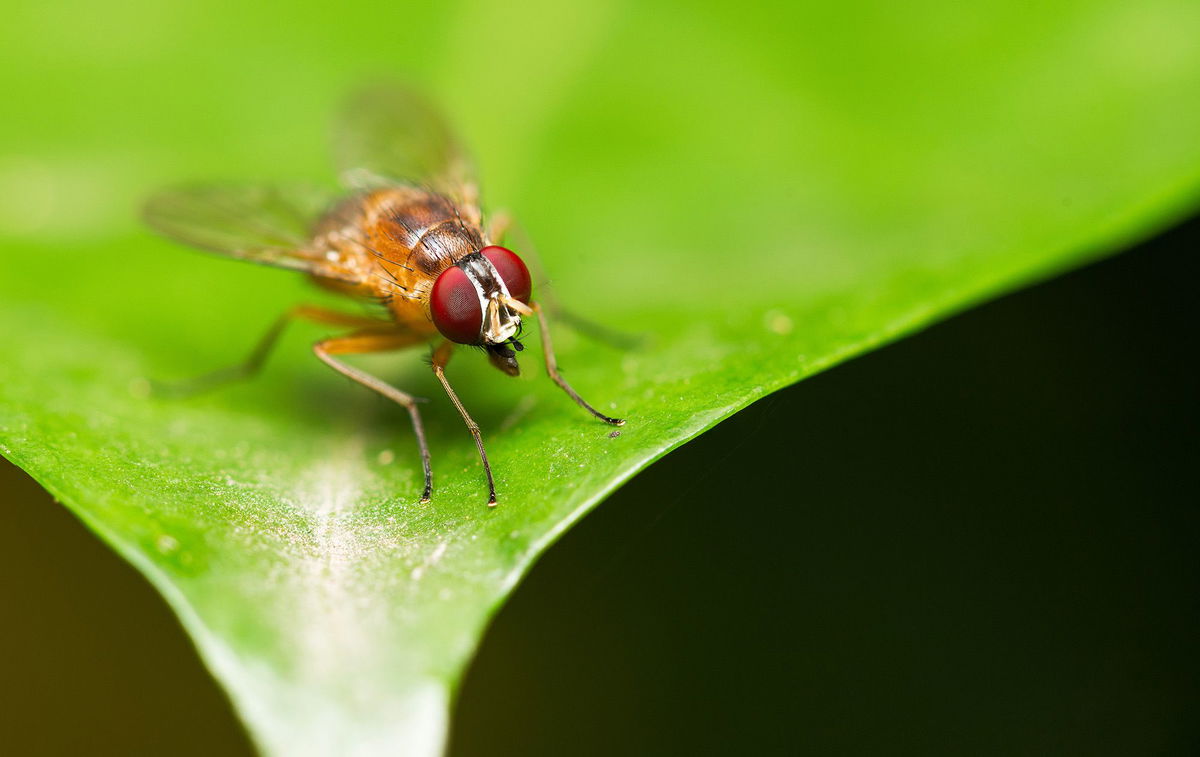Scientists take major step in unraveling mystery of virgin birth phenomenon

A fruit fly of the species Drosophila melanogaster
By Jackie Wattles, CNN
(CNN) — In a historic first, scientists have used gene editing to induce virgin birth in fruit flies, a major step in unlocking the mysteries of the intriguing phenomenon known as parthenogenesis.
Virgin births do not happen naturally in the type of fruit flies involved in the research, said study coauthor Alexis Sperling, a developmental biologist at the UK’s University of Cambridge.
However, Sperling and her team were able to use gene mutations to produce generations of female fruit flies capable of reproducing entirely on their own — without interacting with male fruit flies, according to a study published July 28 in the journal Current Biology.
While virgin births occur naturally in many animal species and have been induced in others — including mice — by manipulating cells, this research marked the first time scientists isolated specific genes to make parthenogenesis a lasting and inheritable trait in an organism not otherwise capable of this type of reproduction.
Though the feat may seem like the stuff of science fiction, take note: It is not the harbinger of virgin births in humans. There are “multiple reasons preventing (parthenogenesis) in mammals. … We need the genetic diversity,” Sperling said.
But the work does mark a key advancement in understanding reproduction across the animal kingdom. And the knowledge may pay untold dividends across a broad range of research efforts.
“I think we need to understand the fundamental aspects of the world that we live in. And sometimes we won’t know the future applications,” Sperling said. “We started understanding how sexual reproduction happens without knowing that we’d be able to do IVF (in vitro fertilization) in the future.”
A how-to for virgin birth
Parthenogenesis has been observed naturally in an array of different animal species, including snakes, birds, lizards, turtles, sharks and crocodiles.
Some fruit fly strains are known to be capable of parthenogenesis, while others aren’t. And that’s where Sperling and her colleagues started: They sequenced the genomes of two types of Drosophila mercatorum — one that solely reproduces sexually and another known to be capable of parthenogenesis.
The researchers were then able to compare the two and narrow down the specific genes that might have given them parthenogenic abilities.
“We had that list, and then I went through the list and picked out basically what I thought it (the genes that trigger parthenogenesis) could be,” Sperling said.
Then her team turned to another species of fruit fly — Drosophila melanogaster — which has never been shown to reproduce through parthenogenesis. And after trial and error, the researchers were able to splice in the correct genes to trigger parthenogenesis for about 11% of female Drosophila melanogaster flies in the experiment. And some of their offspring were also capable of the practice.
The researchers used fruit flies because they’re considered “model organisms,” meaning the flies are among a list of organisms that scientists have long studied in depth to gain a better fundamental understanding of biology. Fruit flies’ short life spans of about 80 days have made it easy to observe changes throughout generations relatively quickly. And prior research into fruit flies is so extensive it’s possible to order genetic mutations for some flies online.
“There’s just so many tools,” Sperling said, “and the tools are easily, cheaply available to all researchers” when it comes to fruit flies.
Parthenogenesis breakthrough: What it means
The researchers noted that just because they were able to induce parthenogenesis in fruit flies doesn’t necessarily mean the phenomenon can be easily replicated in other animal species.
“We haven’t tested every single gene or every single gene combination,” Sperling said. “So there are different things about parthenogenesis that could involve other genes that we were not looking at.”
But this study does provide a road map for how parthenogenesis might one day be induced in other animals.
“This is one where you kind of have to kind of do it and see if it works,” she said.
Sperling added that the research could potentially help to address some crop pests that use parthenogenesis to procreate when male mates aren’t available, allowing them to multiply in droves and overpopulate.
Pesticides halted the reproductive abilities of males in a moth species in the United Kingdom, for example, and females were able to begin using virgin birth to grow their numbers exponentially.
Clearly, the pesticides haven’t been entirely effective. And Sperling said she hopes the work of her team could help inform how to develop better methods for curbing pest populations.
“Are there other kinds of sexual reproduction blocking mechanisms for pest control out there?” she said. “These really need to be looked at.”
Dr. Warren Booth, a researcher at Virginia Polytechnic Institute and State University who recently published a study on the first virgin birth recorded in crocodiles, said the research by Sperling and her team immediately piqued his interest — and he doesn’t believe it needs to lead to immediate real-world applications to be exciting. Booth was not involved in the new study.
“A lot of what we do should be because we’re advancing our basic understanding of biology,” Booth said.
“I think it’s just a great paper,” he added, noting that it confirms what his work on parthenogenesis has long suggested — that it’s a genetic, inheritable trait.
“Ten years ago, we didn’t think that we’d be able to sequence a genome for $1,000, and now we can,” Booth said. “So technology is changing dramatically. And I suppose we could never say never. It wouldn’t shock me if in a very short period of time, there could be (a similar revolution with) gene editing.”
The-CNN-Wire
™ & © 2023 Cable News Network, Inc., a Warner Bros. Discovery Company. All rights reserved.